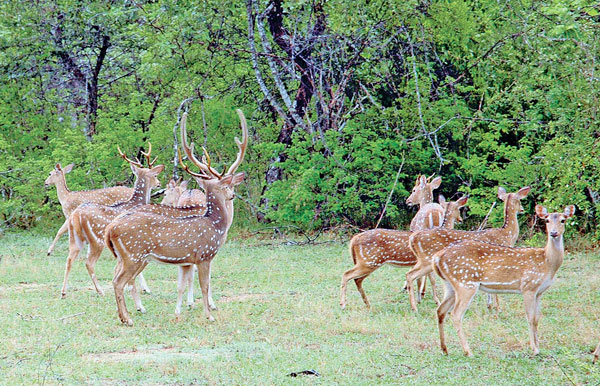
Call of climate change
The focus of the article is to link conservation and access to water to support life and the economy, protecting forests and plants and implementing obligations pertaining to the Paris Climate agreement.
“Climate change has emerged as a key concern for Sri Lanka and its people in the 21st Century. Sea level rise, warming temperatures, uncertain effects on forest and agricultural systems, and increased variability and volatility in weather patterns are expected to have a significant impact in the developing world, where people remain most susceptible to the potential damages and uncertainties inherent in a changing climate.” Source: National Physical Planning Policy and Plan. Sri Lanka 2006-2030 (final draft).
(Pictures by Susantha Wijegunasekara)
Biodiversity and ecosystem services
Sri Lanka has a total land area of 65,610 km2. “Wetlands, both natural and man-made, were the centres of Sri Lanka’s ancient hydraulic civilization and formed the hub of its (Sri Lanka’s) cultural, economic and social evolution. Due to the system of land use adopted in ancient times, catchment areas and other important wetlands in the uplands were preserved under forest cover, while the Dry Zone lowlands were irrigated using water from thousands of rainfed tanks dotted throughout this region. This system of land use served to conserve the biodiversity of natural wetlands. There is also evidence that the conservation of biodiversity in man-made tanks was given consideration in Royal Decrees as early as the 12th Century A.D.” Source: MOFE, 1999.
Here are some examples of ecology and life within. Bees are the most important pollinators of flowering plants including agricultural crops resulting in fruits and seed production. Most of the world’s crops are pollinated by bees comprising more than 20,000 identified species and a similar number of species awaiting identification.
The maritime zone of Sri Lanka is inhabited by 30 species of marine mammals in monsoon scrub jungle in the northwest and southeast, monsoon forest and grassland, inter monsoon forest, rain forests and grasslands below 3000 feet, between 3000-5000 feet and above 5000 feet.
Dry forests, savanna and grasslands are the three major natural terrestrial vegetation types found in the dry land of Sri Lanka.
Four percent of the country’s land area is covered by water (FAO, 2011). Sri Lanka has an extensive network of rivers and streams, most of which arise from the south central massif that rises to 2500 m above sea level. In all, there are 103 distinct natural rivers many of which are perennial, while those in the dry zone are seasonal. Sri Lanka is endowed with a rich array of man-made lakes and canals accounting over 10,000 countrywide, covering more than 127,070 ha, especially in the dry zone.
Sri Lanka harbours over 370 aquatic or wetland plant species of which 12% are endemic to the country. They provide an array of human benefits including food and drinking water, raw material, and medicinal herbs. Wetlands are considered as the transitional zone between land and water and provide several ecological functions such as ground water buffering and reducing pollution.
Why forests will make or break the climate fight
“Reducing emissions is not only about mitigating emissions from our industrial sectors; it can also be about protecting our forests”, forests can also actively sequester carbon dioxide” . Forests also provide ecosystem services such as protection from floods, clean air and water, medicinal plants, and are a sacred and cultural place for many people.
The montane forests, also known as upper montane forests, occur at elevations beyond 1500 m above mean sea level. They share an average temperature of about 16 degrees Celsius and rainfall of above 2000 mm without any marked dry periods, and humidity above 80 percent. Montane forests once formed a more or less continuous cover or cap extending over almost the entire third peneplain of Sri Lanka, encompassing the Pedro, Totapola and Adam’s peak ranges, and the Knuckles range.
Enhancing knowledge and expertise
Research is a key factor to enhancing our understanding of climate science so that we can develop effective adaptation measures. An understanding of regional and local climate is essential to building resilience, as we are located in an area at high risk to the effects of climate change.
Options for adaptation should, prioritize monitoring and identification of the probable impacts of climate change on the most vulnerable and/or important components of biodiversity in the country and promote their conservation, using methods based on both scientific principles and traditional knowledge. The ‘Ecosystem Approach’ promoted by the Convention on Biological Diversity (CBD) offers excellent opportunity to meet this goal.
The Paris Agreement: what’s next?
The agreement provides a framework that allows nations to submit pledges, also known as “nationally determined contributions”, over recurring cycles. The whole of government as well as the economy to realign, to look at ways to bring down our business-as-usual emissions.
Adaptation to climate change is not merely to address projected changes, but to address already manifested impacts that are affecting many ecosystems and species. Conservation of biodiversity and maintenance of ecosystem structure and function are important climate change adaptation strategies because genetically diverse populations and species rich ecosystems have greater potential to adapt to climate change. For example, increasing the health of coral reefs may allow them to be more resilient to increased water temperature and to reduce their susceptibility to bleaching events. (SCBD, 2003).
Source:31/08/2016 Dailly News http://www.dailynews.lk/?q=2016/08/31/features/91849





